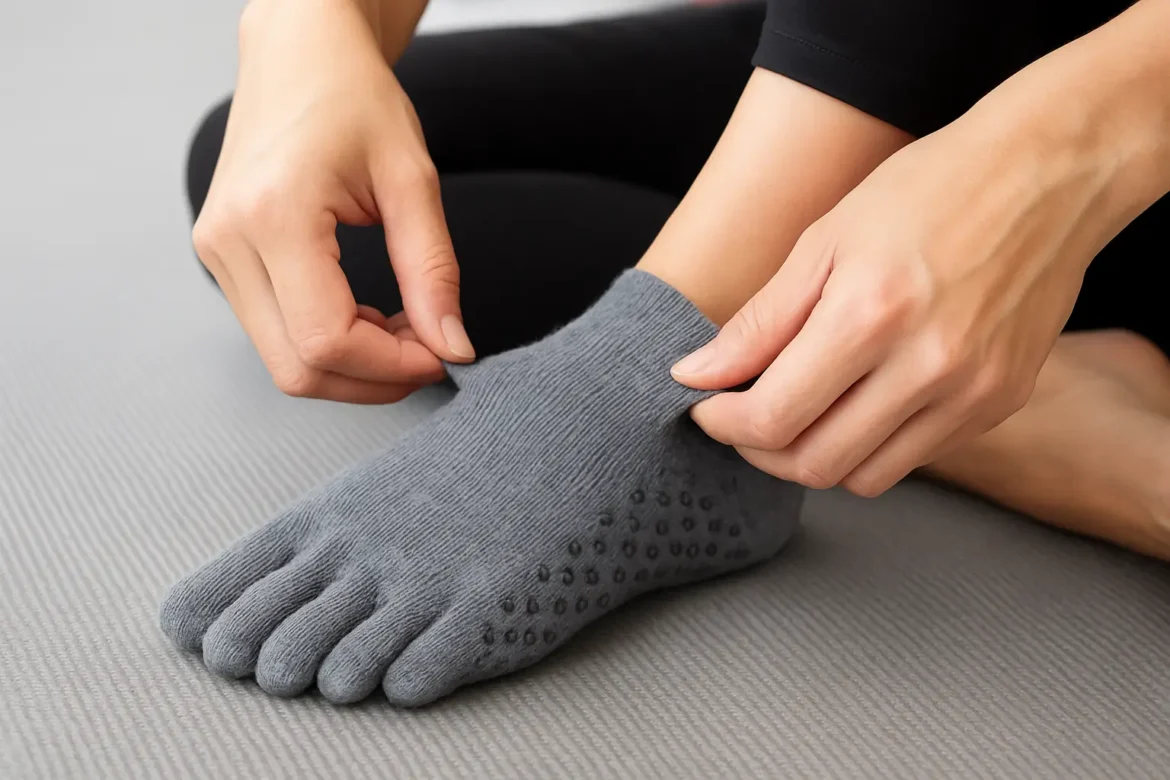Here’s the thing: I had no idea how to wear grip socks properly when I first started training. I’d slide them on, lace up my shoes, and wonder why I was still slipping around mid-sprint or losing balance in class. It wasn’t until I almost rolled my ankle during a five-a-side football game that I realized placement matters more than I thought.
I’d been wearing my grip socks backwards, bunching them under my heel, and basically cancelling out all the benefits they’re supposed to give. Real talk, I was doing it all wrong.
So, if you’ve ever felt your socks twist, slide, or lose traction halfway through a workout, this guide’s for you. I’ll break down exactly how to wear grip socks the right way, the mistakes I made, and how you can avoid them, whether you’re training, doing yoga, or playing football.
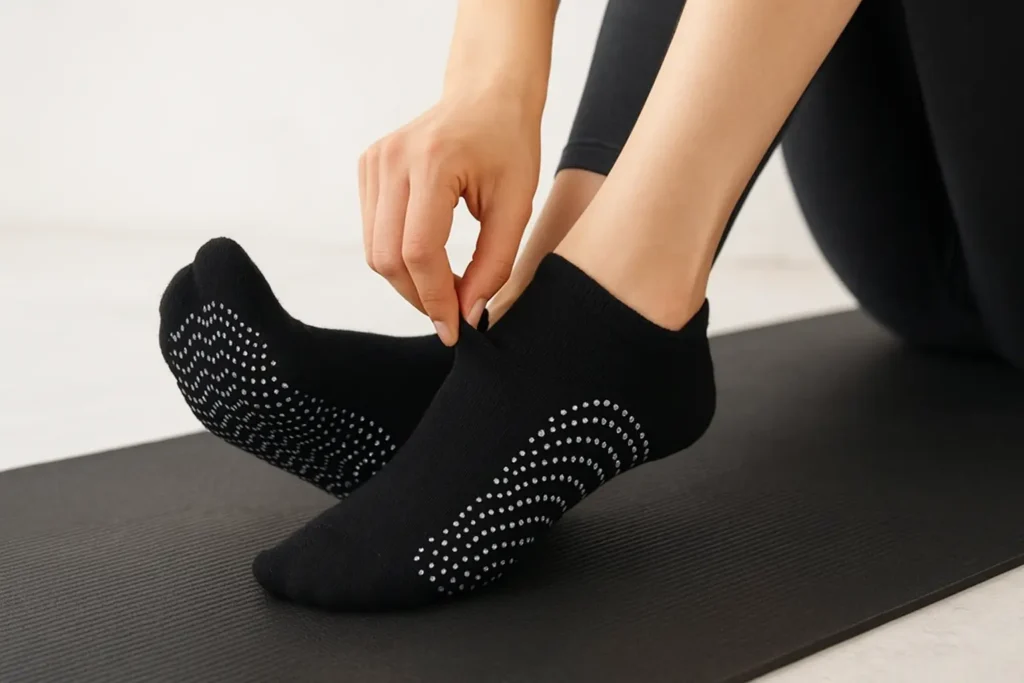
Quick Answer
If you’re short on time, here’s the TL;DR:
Wear grip socks so the grip zones align directly under your sole, never layered over a regular sock. For football, put them on first and pull your team sock over. For yoga or Pilates, wear them alone with correct toe alignment.
Why Grip Sock Placement Matters
Here’s the deal: the way you wear your grip socks changes how well they actually work. The whole point of grip socks, whether they’re for football, Pilates, or general training, is that the silicone or rubberized dots sit directly under your foot’s pressure zones. That’s your heel, arch, and forefoot.
If those don’t line up? You might as well be wearing regular socks. I learned that the hard way.
Once, I wore my pair of TruSox 3.0 Mid-Calf Socks backwards during a gym circuit. I thought the grip dots were “symmetrical.” Spoiler: they weren’t. By round three, the dots were pressing into the tops of my toes instead of under them. I ended up with blisters and no traction.
So, placement matters. Always check where the grips are — they should face down, aligned with the natural curve of your foot. Think of it like this: the sock’s grip pattern should mirror the tread of your shoes.
Step-by-Step Guide
Let’s break it down sport by sport — because what works for football doesn’t necessarily work for Pilates.
For Football / Soccer
If you’ve ever watched pros, you’ve probably noticed they often cut their team socks in half. That’s not a weird fashion choice — it’s a functional one.
1. Put on your grip socks first.
Start with your TruSox 3.0, Grip Socks, or any football-specific brand you’ve got from Amazon. Pull them up so they’re snug around the arch, and make sure the grip pattern sits evenly under your foot — heel to toe.
2. Align the grip pattern.
Check that the dots are evenly distributed and not twisted. If the grips sit off-center, you’ll lose the traction they’re designed to give.
3. Pull your team socks over them.
This keeps you compliant with kit rules while maintaining the benefit of grip. Some players cut the bottom off their official socks and wear them as “sleeves” over the grip sock. You can tape the joint if your league allows.
4. Check your fit inside your boots.
Your boots should feel snug, not tight. If your foot feels cramped, your socks are either too thick or misaligned.
Why this order matters:
Wearing grip socks under your team sock means the grip sits right between your skin and your boot’s insole. That’s where it belongs. If you flip the order, you’ll lose traction completely.
Common mistake: wearing them backwards. The logo usually faces up or outward; the thicker grip zones face the ground. If in doubt, look at the manufacturer’s photos on Amazon; they show the correct orientation.
For Pilates / Yoga
Yoga and Pilates are more sensory practices; you want a connection to the mat while staying stable.
1. Wear them alone — no outer sock.
For example, I use ToeSox Elle Half Toe Grip Socks and Tavi Noir Savvy Grip Socks. You don’t need another layer. The grip dots should meet the mat directly.
2. Check your toe placement.
If you’re wearing open-toe socks, each toe slot should align naturally. No twisting. If it feels tight, readjust before starting class.
3. Make sure the heel grip sits right.
When your heel lift or bridge work starts, you’ll want that heel grip centered. If it’s off, you’ll feel slipping during hip raises or planks.
4. Studio etiquette.
Keep your socks clean. Nobody likes seeing dirty soles in class. Most studios also prefer grip socks for hygiene, especially on reformers.
My first Pilates session with grip socks? I wore them over thin regular socks because I thought “more cushion = better.” Nope. My feet slipped worse because the inner layer reduced traction.
For General Sports / Training
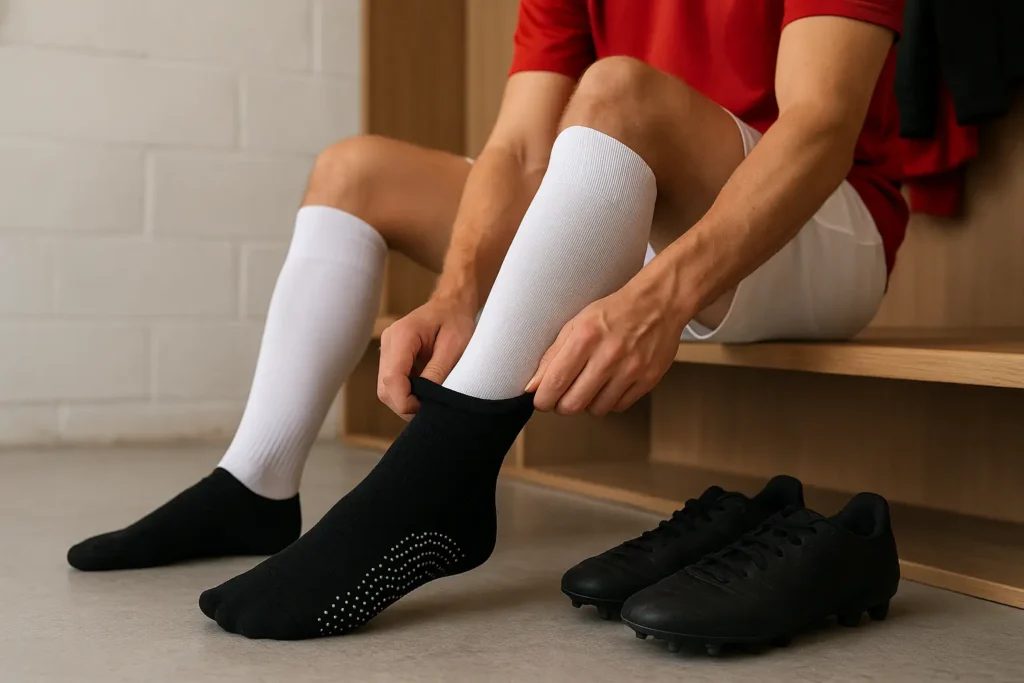
Grip socks are amazing for cross-training, gym circuits, or even running — if you use them right.
1. With or without shoes:
If you’re wearing shoes, test your fit first. Some grip socks, like LA Active Non-Slip Training Socks or Athletic Crew GriSocks, add thickness, so size your shoes accordingly.
2. Align your grips inside your shoe.
They should contact the insole, not twist around your arch. If you feel bunching, take them off and reset.
3. Avoid layering over normal socks.
That kills the friction between sock and shoe. The point of grip socks is to prevent internal movement — layering brings it back.
4. Without shoes:
If you’re training barefoot (say, HIIT on wood floors), make sure the grip covers the heel and forefoot equally. You’ll feel way more secure in lunges or push-ups.
Common Mistakes
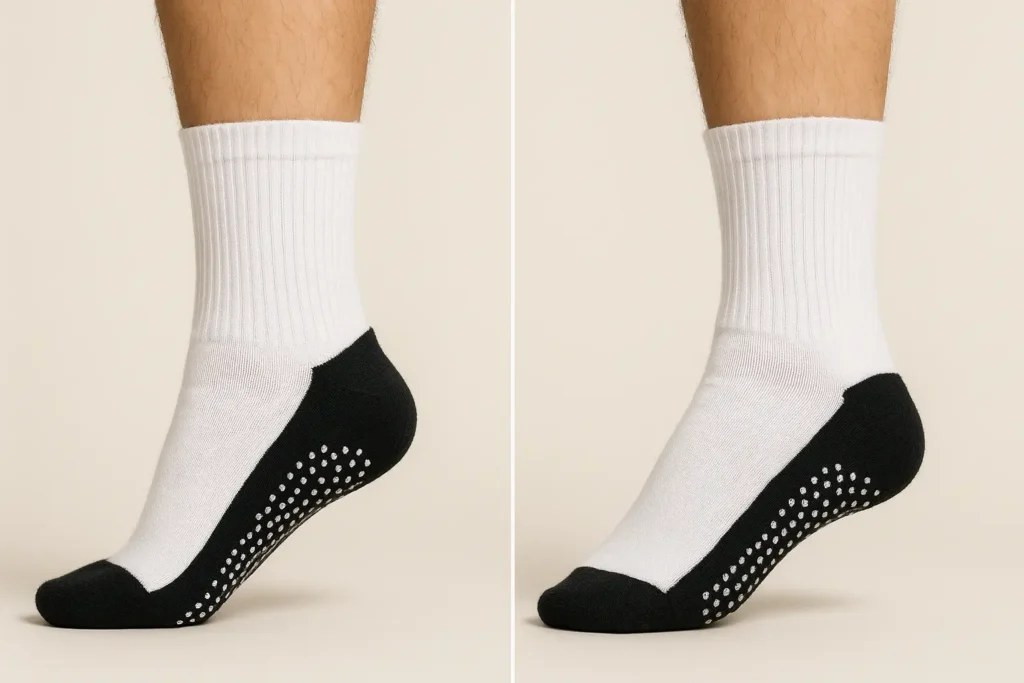
Let’s be honest, I’ve made almost every mistake possible. So here’s how not to wear grip socks.
Mistake 1: Wearing Them Backwards
It happens. The easiest way to tell? Most grip socks have the brand name or logo facing upward near the ankle, not underfoot. The grip dots always go underneath.
I once wore my Bombas Gripper Socks backward during a reformer class. Halfway through leg circles, I realized I was sliding everywhere. My instructor laughed and said, “You’re not gripping much today, huh?” Lesson learned.
Mistake 2: Wrong Size
Too loose and you’ll slip inside your own sock. Too tight and your toes will go numb. Neither helps.
Sizing varies by brand, but if you’re between sizes, I recommend going smaller. Socks stretch. For reference, I wear a women’s size 8 and size down for Tucketts Allegro Open-Toe Grip Socks, perfect snug fit.
Mistake 3: Wearing Over-regular Socks
I get it, you think you’re adding cushioning. But you’re actually removing the friction between your foot and the sock. The silicone grips can’t do their job.
The only time this is remotely okay is in football when you’re wearing the cut-sock method for uniform reasons, but even then, the grip sock is still the bottom layer.
Mistake 4: Not Washing Them Right
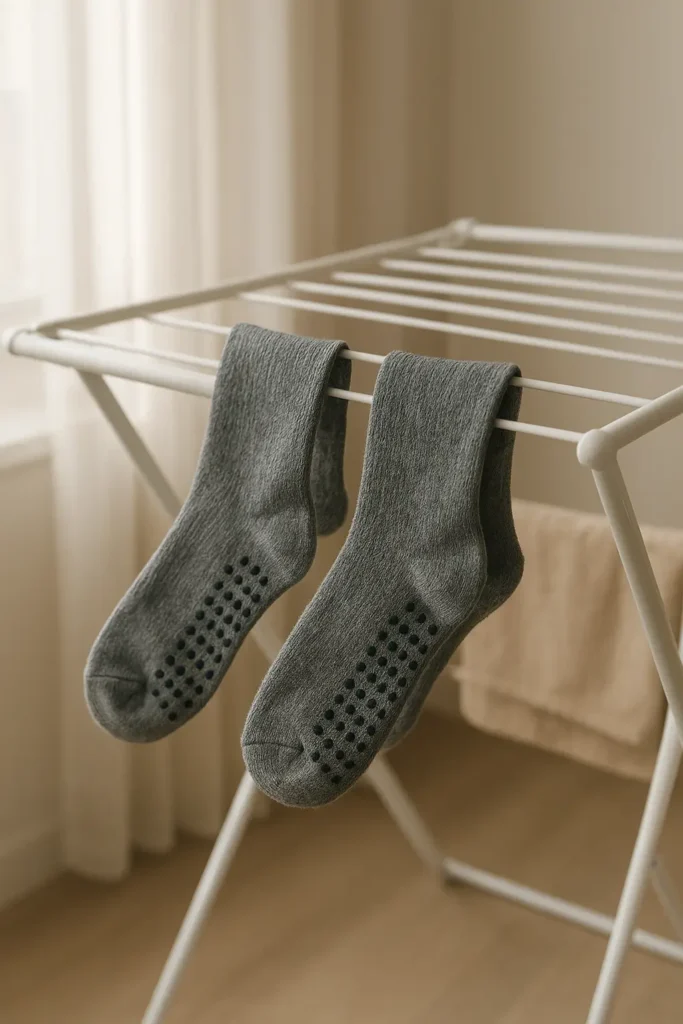
This one’s huge. Grip socks need care. Washing them hot or with softener will ruin the grips.
I once tossed my ToeSox in the dryer after class because I was in a rush. Big mistake. In the next session, the dots were smooth instead of tacky. Always wash cold, air dry, and skip softeners.
Sport-Specific Tips
Football:
Use the “cut sock” method. Cut the foot off your team socks, wear your grip socks (like TruSox 3.0), then pull the team sleeve over. Tape if needed.
Pilates:
Choose open-toe for reformer, closed for mat. Open-toe helps your toes grip the bar naturally.
Running:
Use lightweight, breathable options like Rymora Non-Slip Socks. They prevent blistering and improve stability in quick sprints.
Hospital / Medical Use:
If you’re wearing grip socks in recovery or post-surgery, look for full-sole grip coverage (like Pembrook Non-Skid Hospital Socks). They prevent slipping on tile floors.
FAQ
Do you wear regular socks under grip socks?
No. The grip needs direct skin contact. Wearing them over regular socks defeats the purpose.
Can you wear grip socks with any shoes?
Mostly yes, training, running, and football shoes work fine. Just make sure your fit isn’t too tight.
Which way do grip socks go?
Grips face down. The heel label or logo usually faces upward or outward.
How tight should grip socks be?
Snug but not restrictive. You should feel supported, not squeezed.
Can you wear grip socks on their own?
Yes, especially for yoga, Pilates, or home workouts. Just keep them clean.
How do footballers wear grip socks?
They wear grip socks first, then pull their team sock (cut at the ankle) over them, often taped together at the join.
Can I use grip socks for weight training?
Absolutely. They’re great for deadlifts or squats if your gym allows shoes off.
Do grip socks lose grip over time?
Yes, if not cared for properly. Wash cold, air dry, and replace when the dots start to flatten.
Conclusion
Honestly, wearing grip socks the right way is simple once you get it — but I had to learn through trial and error (and a few embarrassing slips). Align the grips with your sole, wear them as the base layer, keep them clean, and choose the right style for your sport.
Once you do, you’ll notice immediate improvements — better stability, comfort, and confidence whether you’re nailing a headstand, sprinting downfield, or just training at home.
If you want to see which grip socks perform best in each category, check out our detailed guides:
👉 Best Grip Socks for Football in 2025
👉 Best Grip Socks for Pilates in 2025
👉 Best Grip Socks for Yoga in 2025
Your feet do the work. Let your socks help them do it right.
**Affiliate Disclosure:** This post contains affiliate links. If you make a purchase through these links, we may earn a commission at no extra cost to you.
